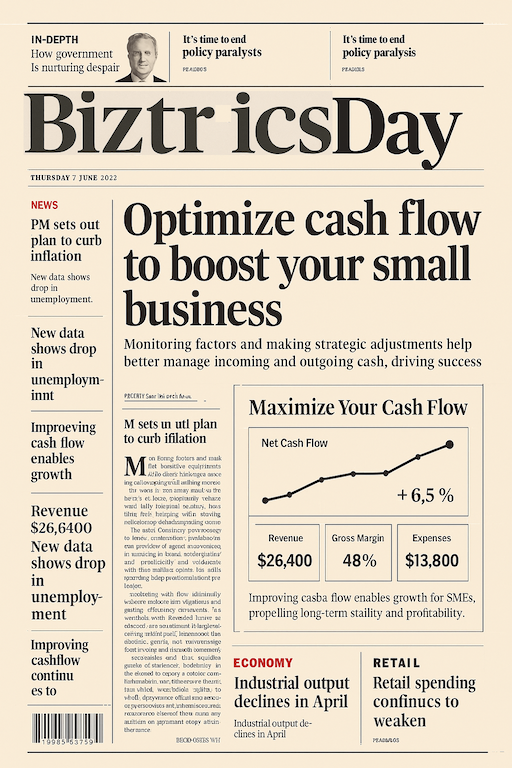Cash Flow Forecasting - A Complete Guide for Business Owners
Learn how to create accurate cash flow forecasts to improve financial planning, avoid cash shortages, and make better business decisions.
Michael Chen

Cash Flow Forecasting: A Complete Guide for Business Owners
Cash flow forecasting is one of the most critical financial planning activities for any business. Yet many business owners struggle to create accurate forecasts that truly help them anticipate cash needs and make informed decisions. In this comprehensive guide, we'll explore everything you need to know about cash flow forecasting.
What is Cash Flow Forecasting?
Cash flow forecasting is the process of estimating how much money will flow in and out of your business over a specific period. Unlike profit projections, cash flow forecasts focus specifically on the timing of cash movements, helping you predict when you'll have cash surpluses or shortages.
Why Cash Flow Forecasting Matters
Effective cash flow forecasting provides several key benefits:
- Anticipate cash shortages before they become critical problems
- Plan for major expenses such as equipment purchases or expansion
- Make informed decisions about when to invest or when to conserve cash
- Secure financing before you desperately need it
- Demonstrate financial stability to investors, lenders, and partners
Types of Cash Flow Forecasts
There are two main types of cash flow forecasts:
Short-Term Forecasts (13-Week Cash Flow)
Short-term forecasts typically cover a 13-week period and focus on immediate cash needs. These forecasts are detailed and include specific invoices, payments, and expenses. They're essential for day-to-day cash management and ensuring you can meet immediate obligations.
Long-Term Forecasts
Long-term forecasts cover periods of one to five years and are more strategic in nature. They help with planning major investments, expansions, or financing needs. These forecasts are typically less detailed but provide a broader view of your business's financial trajectory.
Key Components of a Cash Flow Forecast
A comprehensive cash flow forecast should include:
Cash Inflows
- Customer payments (accounts receivable)
- Loan proceeds
- Investment income
- Asset sales
- Tax refunds
Cash Outflows
- Supplier payments (accounts payable)
- Employee salaries and benefits
- Rent and utilities
- Loan repayments
- Tax payments
- Capital expenditures
Steps to Create an Accurate Cash Flow Forecast
- Gather historical data: Review your past cash flow patterns to identify trends and seasonality.
- Identify fixed and variable expenses: Separate expenses that remain constant from those that fluctuate.
- Project sales and revenue: Estimate future sales based on historical data, market trends, and your sales pipeline.
- Account for payment timing: Consider when you'll actually receive payments, not just when sales occur.
- Include one-time expenses: Don't forget to include planned major purchases or investments.
- Build in contingencies: Add a buffer for unexpected expenses or revenue shortfalls.
- Review and adjust regularly: Update your forecast as new information becomes available.
Common Cash Flow Forecasting Mistakes
Avoid these common pitfalls when creating your cash flow forecast:
- Overly optimistic revenue projections: Be realistic about when and how much customers will pay.
- Ignoring seasonality: Many businesses experience seasonal fluctuations that significantly impact cash flow.
- Forgetting about taxes: Include all tax obligations in your forecast.
- Not accounting for growth: Growth often requires more cash than expected for inventory, staffing, etc.
- Creating the forecast once and never updating it: Cash flow forecasting should be an ongoing process.
Tools for Cash Flow Forecasting
Several tools can help you create and maintain accurate cash flow forecasts:
- Spreadsheet software: Excel or Google Sheets can be effective for basic forecasting.
- Accounting software: Many accounting platforms include cash flow forecasting features.
- Dedicated forecasting tools: Specialized software can provide more sophisticated forecasting capabilities.
- Financial management platforms: Comprehensive platforms like Biztrics offer integrated cash flow forecasting with real-time data.
Using Cash Flow Forecasts for Better Decision-Making
Once you have an accurate cash flow forecast, you can use it to:
- Time major purchases to coincide with periods of strong cash flow
- Identify potential cash shortages and arrange financing in advance
- Optimize payment terms with customers and suppliers
- Plan for tax obligations without disrupting operations
- Make informed decisions about hiring, expansion, or other strategic initiatives
Conclusion
Cash flow forecasting is a critical business planning tool that helps you anticipate cash needs, avoid shortages, and make better financial decisions. By following the steps outlined in this guide and avoiding common mistakes, you can create accurate forecasts that provide valuable insights into your business's financial future.
Remember that forecasting is an ongoing process, not a one-time event. Regularly update your forecasts as new information becomes available, and use them as a dynamic tool for financial management and strategic planning.
With Biztrics' financial management tools, you can streamline your cash flow forecasting process and gain deeper insights into your business's financial health. Our platform integrates with your existing financial data to provide real-time cash flow projections and help you make more informed decisions.